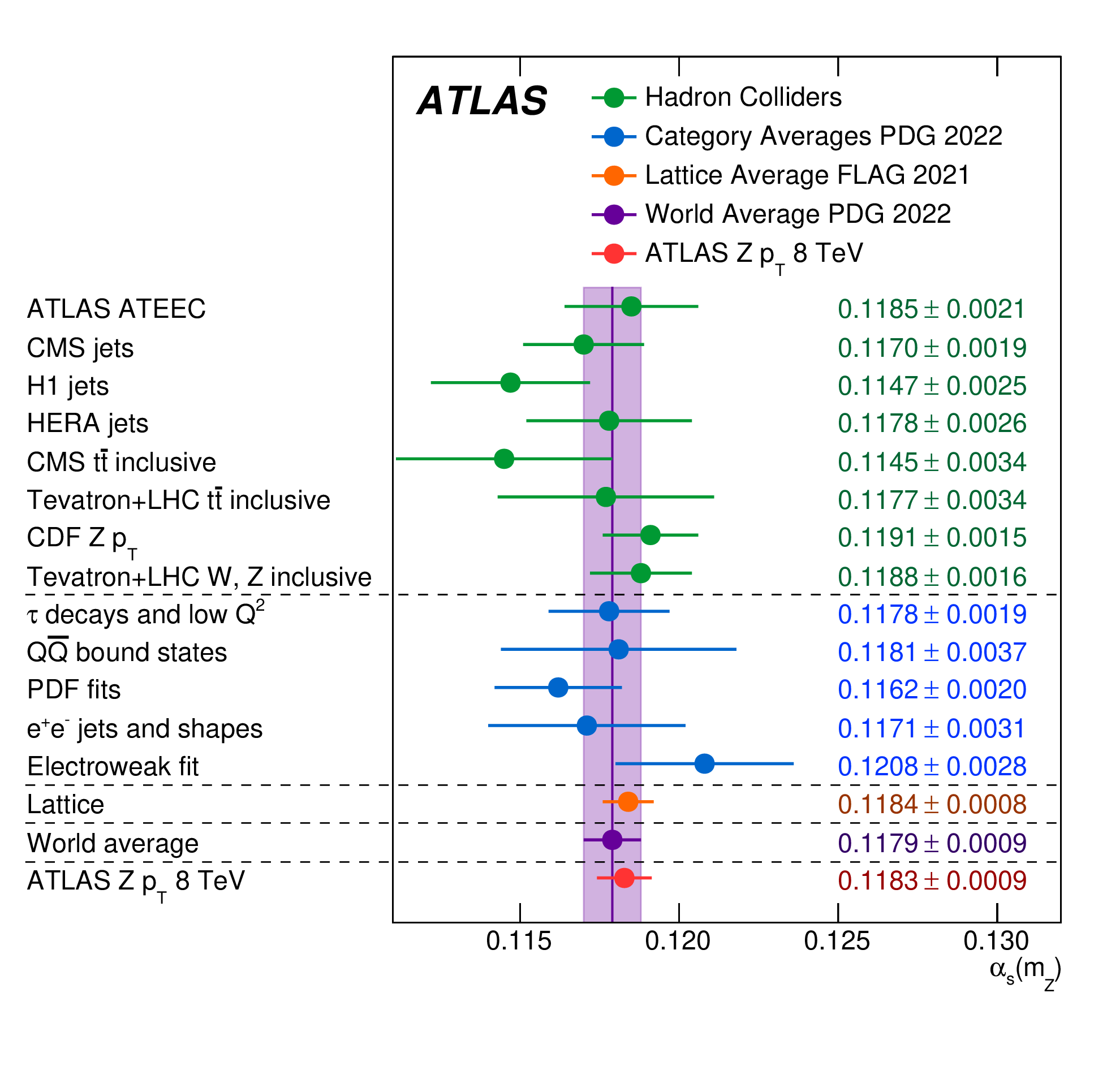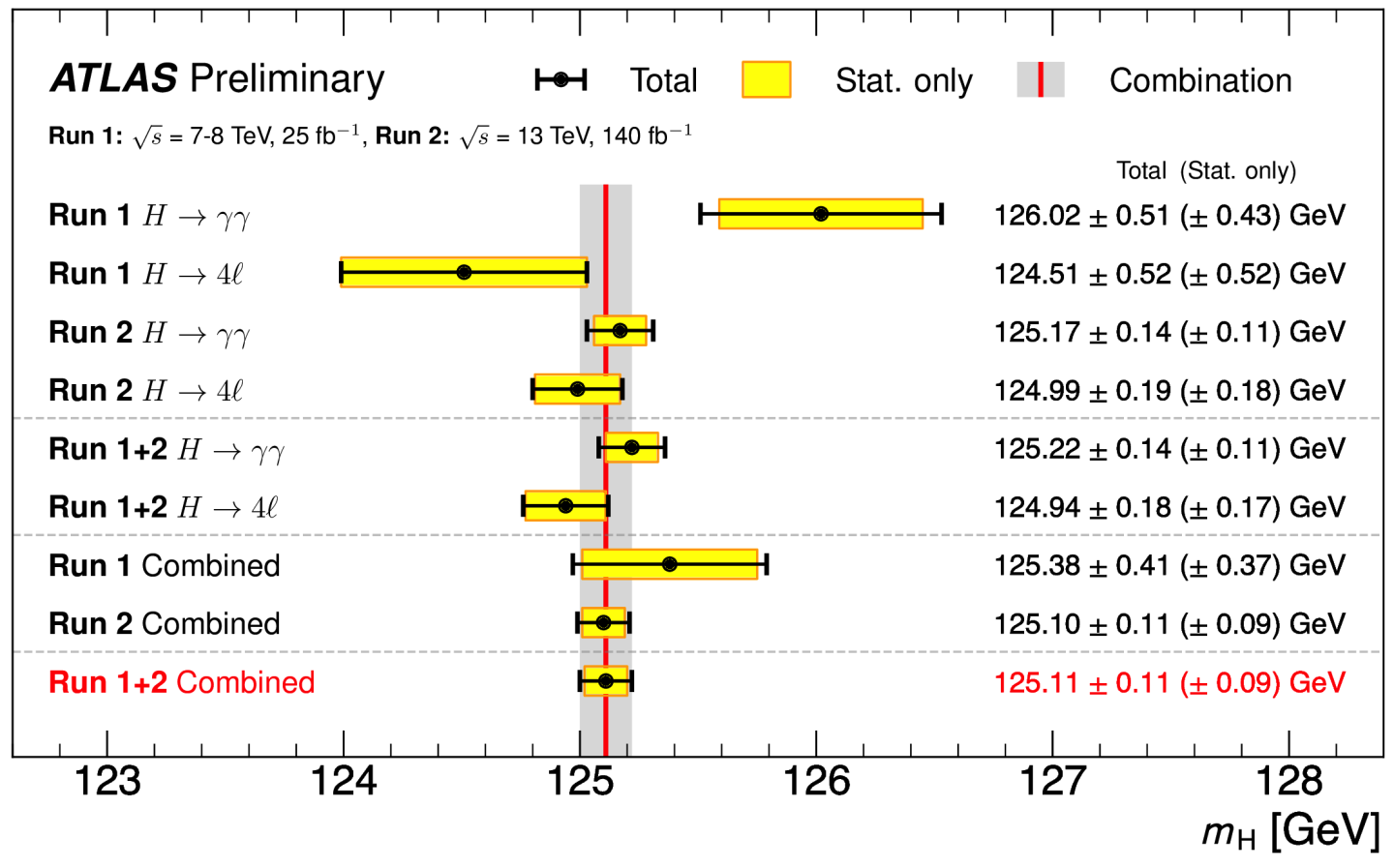ATLAS measures the strength of the strong force
23 March 2023 | By
The ATLAS Collaboration at CERN has released a precise new measurement of the Z-boson transverse momentum. This has allowed researchers to determine the strength of the strong force. Their result has less than 1% uncertainty, making it the most precise determination of the strong force ever made by a single experiment.
Binding together the nucleus is a force so strong, it’s in the name. The strong force is a fundamental force that acts only on the nuclear scale. It is almost absent between objects that are very close (less than a femtometre apart!), but grows stronger when those objects are pulled apart. The discovery of this behaviour in 1973 (called asymptotic freedom) was awarded the Nobel prize in 2004. Quarks and gluons are the building blocks of protons. While quarks can move freely inside a proton, they combine in pairs or triplets when they are pulled apart. If they are kicked-out of the proton with high transverse momentum, the quark will grab other produced quarks and anti-quarks and produce many strongly-interacting particles. Thus quarks can never be seen by themselves, making measurements of the strong force that acts between them (the strong coupling, αS) especially difficult.
The coupling is a basic parameter that characterises the strength of a force in an interaction between fundamental particles. The strong coupling is the least precisely measured of the fundamental couplings of nature. A better understanding of the strong coupling will lead to better predictions for the production and decay of strongly produced particles. Further, it can address fundamental unanswered questions about nature. Could the forces be of equal strength at very high energy, indicating a potential common origin? Could new, unknown interactions be modifying the strong coupling in certain processes or at certain energies?

The results of a strong study
For this precise new measurement, ATLAS researchers studied the production of Z bosons in proton-proton data collected at a centre-of-mass energy of 8 TeV. Z bosons are typically produced when two quarks in the colliding protons annihilate, which is a weak-interaction process. The strong force comes into play through the radiation of gluons off the annihilating quarks. This process (see Figure 1) gives the produced Z boson a “kick” transverse to the beam axis, which is measured as transverse momentum. The size of this kick depends on the strong coupling. A precise measurement of the Z transverse momentum and comparison to equally precise theoretical calculations allows ATLAS physicists to measure αS. Since the Z boson decays instantly after being produced, its transverse momentum is measured via its decay products.
The new ATLAS result is compatible with the world average and is the most precise single measurement to date.

In this analysis, researchers focused solely on Z-boson decays to two leptons (electrons or muons), allowing them to measure the Z-boson transverse momentum from the decay products with a precision of better than 1%. That measurement is extended by a measurement of the Z boson’s rapidity, a quantity related to the Z emission angle with respect to the beam axis. The rate (or cross-section) of Z boson production versus transverse momentum and rapidity allowed researchers to precisely determine the strong force coupling strength to be αS(mZ)= 0.11828 +0.00084 −0.00088 (see Figure 2).
Pushing theory to new levels
The precision of the result depends on several factors, including the accuracy of the theoretical description and the precision to measure the decay products of the Z-boson in the detector. ATLAS physicists used cutting-edge theory calculations of the production process. These calculations are very complex, so physicists first calculate step-by-step the simpler important contributions (leading order, LO) and then include the more complex corrections. The more terms, the better the precision. To enable the extraction of αS with unprecedented precision, physicists developed theoretical calculations that included processes with up to four “loops” in Quantum Chromodynamics (QCD, a perturbative quantum field theory that describes the strong force), and adjusted in the extraction certain parameters describing the parton distributions (PDF) and the model of the small transverse momentum of the quarks inside the proton.


High-precision detector measurements
On the experimental side, physicists were able to measure the electrons and muons (resulting from the Z-boson decay) with precisions ranging from 0.1%, in the central detector part (low rapidity), to 1%, in areas closer to the LHC beamline (large rapidity). The large acceptance of the ATLAS electromagnetic calorimeter system allowed the measurement of electrons in detector areas to be extended to where no tracking system is active (very large rapidity). Key to extracting this precision measurement was the detailed understanding of the detection efficiencies and momentum calibration of the two electrons or two muons coming from the Z-boson decay. Figure 3 shows the measured Z-boson cross-section as a function of its transverse momentum and in different rapidity regions.
The value of αS is obtained by simultaneously adjusting it together with other theoretical modelling parameters to the measured Z-boson cross-sections. Figure 4 shows the results of the fit carried out for different accuracy levels of the theory prediction.
The new ATLAS result is compatible with the world average and is the most precise single measurement to date (see Figure 2). This measurement showcases that competitive precision physics is possible at a proton-proton collider.
Learn more
- A precise determination of the strong-coupling constant from the recoil of Z bosons with the ATLAS experiment at 8 TeV (ATLAS-CONF-2023-015)
- Measurement of the transverse momentum and rapidity distributions of the boson at 8 TeV with the ATLAS detector (ATLAS-CONF-2023-013)
- Moriond EW 2023 presentation by Stefano Camarda: Precise measurement of the Z production properties in ATLAS



